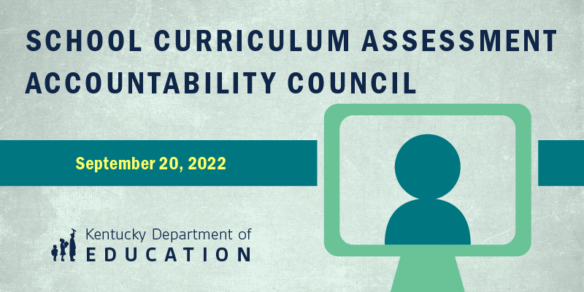
The Kentucky Department of Education’s (KDE’s) School Curriculum, Assessment and Accountability Council (SCAAC) discussed the recent standard-setting process for Kentucky’s new accountability system during its Sept. 20 regular meeting.
Rhonda Sims, associate commissioner in KDE’s Office of Assessment and Accountability (OAA), and Jennifer Stafford, division director in OAA, gave the council a recap of the two-day standard setting meeting that took place on Sept. 13-14. The standard-setting panel set cut scores that define performance expectations for each indicator and the overall school rating. The cut scores determine how schools are reported in the online colored dashboard required by state law.
“Kentucky has … committed across the years to having a transparent [standard-setting] process, and not every state does that,” said Sims.
Using data from the 2021-2022 school year, Kentucky’s accountability system will provide an overall color-coded rating for each school, district and the state ranging from red (lowest) to blue (highest). The color-coded rating, along with other important education data, will be available on the Kentucky School Report Card, which is set to be publicly released on Oct. 18.
Facilitated by staff from the national Center for Assessment, the standard-setting group discussed performance level descriptions (PLDs), which are performance expectations for each color. PLDs were discussed for each indicator and overall school ratings, and were used to help set the cut scores that fall into each of the colors.
Sims stressed the importance of bringing a diverse group of voices to the table at the standard-setting meeting. The panel was made up of 26 members, including teachers, principals, superintendents, parents, students, state board members and other education stakeholders. It also included two SCAAC members: Artavia Acklin, principal of Painted Stone Elementary (Shelby County), and JanaBeth Francis, SCAAC chair and district assessment coordinator for Daviess County.
“To be in the room with everybody that was passionate … about accountability and doing what’s best for kids, I could not have had a better experience. I am so grateful that everybody’s voice was heard,” said Acklin.
Francis said she appreciated the assistance from the Center for Assessment and KDE staff, and the discussions among the panelists.
“I’m thankful KDE included two members of this council to be on that work,” she said. “There wasn’t a single person on the committee who didn’t take their job seriously, who didn’t commit to really digging into the data and making decisions, and then probably most importantly, being able to voice why they made those decisions.”
Districts will be able to see their own preliminary data for the first time on Sept. 22 during a quality control activity. District assessment coordinators and other key staff will review for any system errors before it goes live on the School Report Card in mid-October.
Update on CSI, TSI and ATSI
Matthew Courtney, policy advisor in the Office of Continuous Improvement and Support (OCIS), joined the council to discuss updates to the federal requirements of Kentucky’s accountability system.
Comprehensive Support and Improvement (CSI), Targeted Support and Improvement (TSI) and Additional Targeted Support and Improvement (ATSI) are federally mandated school identifications that are based on the overall school score that is generated by the state accountability system.
CSI status schools will be identified based on two criteria: If the school is in the bottom 5% of all schools based on the overall school score, or if they have a graduation rate below 80%.
Normally, a third criteria is used to identify a CSI school, which includes any ATSI school that fails to exit the category within three years. KDE secured a waiver from the U.S. Department of Education that allows KDE to not count the previous two years during the pandemic, so no schools will be identified as CSI using that category.
KDE also will not be identifying any new ATSI schools this fall, but there may still be ATSI schools that were identified prior to the COVID-19 pandemic and did not meet the established exit criteria.
TSI schools are those who have a subgroup performing at or below the bottom 5% of all schools. TSI schools will be identified this fall based on one year of data.
In other business, SCAAC:
- Heard an update from Stafford on the status of the Kentucky Academic Standards for Science and science assessment blueprint. The purpose of the blueprint is to communicate to educators and other stakeholders what to emphasize within the standards in their classrooms. The blueprint also is used as a framework for assessment vendors to develop assessments and other items used with assessments;
- Heard an update on the Kentucky Reading Academies’ Language Essentials for Teachers of Reading and Spelling professional learning opportunity from Christie Biggerstaff, director of early literacy in KDE’s Office of Teaching and Learning; and
- Heard an update on the United We Learn work from Sarah Snipes, program manager in OCIS.



Leave A Comment